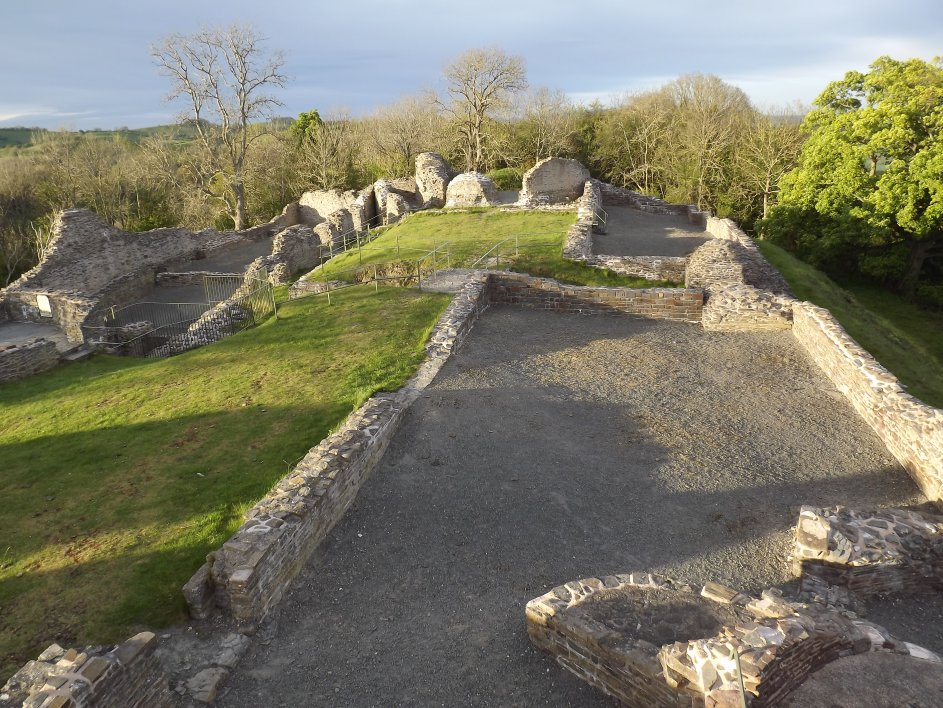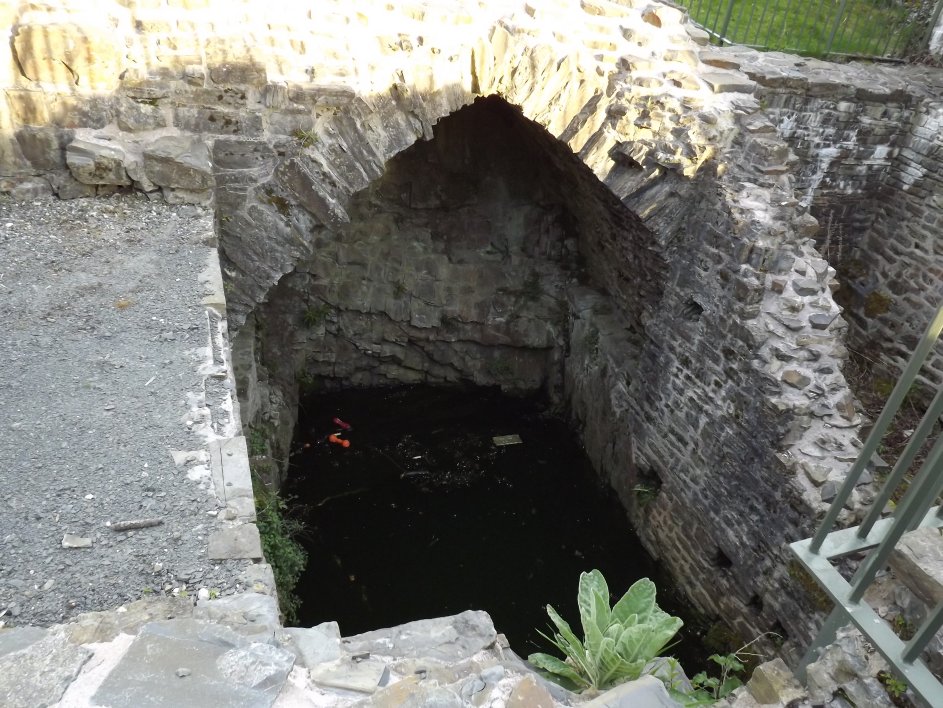Dolforwyn

Maredudd ap Rhobert was lord of Cedewain from about
1210 until his death in 1244. In 1248 Cedewain was restored to
his son, Owain ap Maredudd (d.1261), by King Henry III. On his death on 1 November 1261, Llywelyn ap Gruffydd
seized his land of Cedewain, despite Owain leaving a legitimate
daughter. This act was confirmed by the 1267 treaty of Montgomery
with Henry III.
Prince Llywelyn is claimed to have been building a new castle above the
River Wye on 3 April 1273 and 3 months later had started 'the repair
and construction of a castle' at Abermule near Montgomery. This
is definitely Dolforwyn and was obviously by the terms that he was
intending 'to erect anew the said castle and to erect anew a borough or
a town and market'. Quite clearly a castle had stood here before
that date. Most castles took several years to built, but by March
1274 Prince Llywelyn is claimed to have finished constructing his new
castle in Cedewain and was planning to build another in Clun Forest to
the south. Soon afterwards the prince called Gruffydd ap
Gwenwynwyn (d.1286) to him when he was at Dolforwyn (Dolvorwyn/Bachyranneleu)
and demanded he explained himself before his council. Quite
clearly a major structure had stood at Dolforwyn and was put back in a
state of fortification in just one year. The strong implication
is that a castle existed here at this time, such a view is reinforced
by 2 pieces of evidence. A contemporary record of 1278 states
that Llywelyn seized the whole of Cedewain 'with the vill of Dolforwyn'
on the death of Owain in 1261. It is all but certain that
Dolforwyn village was only built after the castle and not the other way
around. Further, if the castle had only been built in 1273, then
why did a local claimant to it, believe it had existed 12 years
earlier, as such a falsehood would certainly have come out in the
subsequent trial that was bound to follow the plea. The next year
the commote and Dolforwyn castle were granted to Roger Mortimer.
Indeed the Mortimer genealogy states quite clearly that King
Henry III (1216-72) granted Roger Mortimer (lord of Wigmore from 1248
to 1282) the lands of Ceri and Cedewain with the castle of Dolforwyn
built by Dafydd ap Llywelyn (d.1246) his uncle. This is wrong,
for the land and castle was only granted with Ceri by Edward I in 1279.
However the fact that Cedewain was held by Dafydd is certain and
that a castle stood there before 1273.
The subsequent history of the castle does not take long to tell.
In 1277 it withstood a fortnight siege and promptly surrendered
to Roger Mortimer and the earl of Lincoln. After being granted to
Mortimer in 1279 it stayed with that family to their extinction in 1425
when it became Crown property. By this time it seems to have been
abandoned. The layout of the castle is usefully listed in a
document of 1322 when the castle was seized by the Crown. Recent
excavation has confirmed this survey.
Description
The castle lies on a ridge end site on top of a hill way above
Abermule. The entrance to the site is commanded by a large
rectangular keep of 2 storeys at the SW end of the site. This was 55' by 40', with walls 8'
thick. It was originally
entered at first floor level from the west. The size of the tower
makes it a close relative to other Powysian castles, viz: Alberbury
(56'x35'x7'), Dinas Bran (60'x50'x8') and Whittington (52'x38'x10'). The Venedotian rectangular keeps, like Criccieth (43'x32'x7'), Dinas Emrys (36'x27'x4'), Dolwyddelan II (44'x31'x8-10') and Castell y Bere (50'x35'), are much smaller.
Probably at a slightly
later date a round tower was built at the other, NE end of the site.
This has a diameter of 40', walls 7' thick and was set centrally in all respects in
the later west curtain. Its positioning in the later walls mimics the north round
tower at Dinefwr, the keep at Llanstephan and the west tower at Castell
y Bere. While the curved approach up a quarter of the keep to a first floor entrance immediately brings to mind the approach to Dolbadarn keep, which at 42' is quite similar in all surviving respects. A list of other round tower keeps can be found in the description of Llanstephan castle and a general list of round keeps is found under Dundrum.
 Joining both towers together is a later curtain wall making a
rectangular site along the highly uneven hill top. There was also
a D shaped Dinas Bran style residential
tower added roughly centrally on the NW front over a cistern.
This makes a mockery of the garrison surrendering for lack of
water in 1277. This castle ward is generally accepted as the work
of Llywelyn in 1273-74. By definition the other two towers must
be older.
Joining both towers together is a later curtain wall making a
rectangular site along the highly uneven hill top. There was also
a D shaped Dinas Bran style residential
tower added roughly centrally on the NW front over a cistern.
This makes a mockery of the garrison surrendering for lack of
water in 1277. This castle ward is generally accepted as the work
of Llywelyn in 1273-74. By definition the other two towers must
be older.
Dividing the site from NW-SE is a rock cut ditch. This quite
obviously predates the internal Welsh gatetower which is currently set
in it. This mimics the main gate to the SW and quite obviously
leads to a split site with two separate castles, one to north centred
on the round tower and one to the south centred on the rectangular
tower. The layout at Machen and to a lesser degree Ewloe is similar and it draws comparison to the earlier English castles of Lincoln and Lewes
with their twin mottes. The most logical conclusion is that all
these sites had a dual lordship. For the Welsh sites this can be
clearly argued here and at Machen. Llywelyn ab Iorwerth (d.1240) was helping the lord of Machen keep off assaults by the Earl Marshall in 1236. At Ewloe there is no evidence of a shared lordship, nor is there at Lewes.
This leaves a conclusion that Dolforwyn castle was initially just a
rectangular 2 storey tower on a hill, possibly built by Maredudd ap
Rhobert (d.1244) or a predecessor. Between 1226 and 1228 and
possibly 1234 to 1238, the overlordship of Cedewain lay with Gruffydd
ap Llywelyn and after that with his son Llywelyn ap Gruffydd up to
1241. In any case up to 1240 Llywelyn ab Iorwerth certainly held
the overall controlling interest in Cedewain. It is quite
possible that one of these was responsible for raising a round tower at
Dolforwyn. This may explain the similarity of this tower to the
round tower at Dolbadarn.
Copyright©2019
Paul Martin Remfry


 Joining both towers together is a later curtain wall making a
rectangular site along the highly uneven hill top. There was also
a D shaped Dinas Bran style residential
tower added roughly centrally on the NW front over a cistern.
This makes a mockery of the garrison surrendering for lack of
water in 1277. This castle ward is generally accepted as the work
of Llywelyn in 1273-74. By definition the other two towers must
be older.
Joining both towers together is a later curtain wall making a
rectangular site along the highly uneven hill top. There was also
a D shaped Dinas Bran style residential
tower added roughly centrally on the NW front over a cistern.
This makes a mockery of the garrison surrendering for lack of
water in 1277. This castle ward is generally accepted as the work
of Llywelyn in 1273-74. By definition the other two towers must
be older.